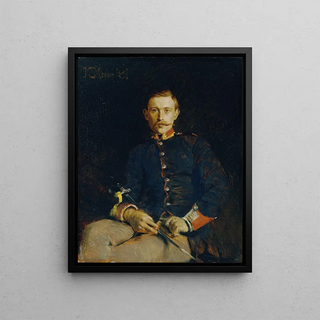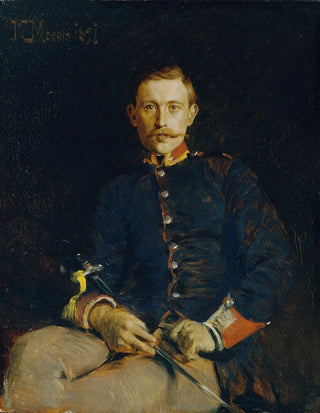Art print | Franz Dangl in uniform - Koloman Moser


View from behind

Frame (optional)
In the vibrant world of early 20th-century Viennese art, the art print "Franz Dangl in uniform" by Koloman Moser stands out for its elegance and depth. This piece, which captures the essence of a man in uniform, is much more than a simple portrait. It reflects an era marked by social and political upheavals, while offering a glimpse into Moser's artistic sensitivity. Exploring this work reveals a dialogue between the individual and their environment, a subtle interaction that invites contemplation. The choice of colors, composition, and meticulous details demonstrate Moser's mastery, who manages to infuse a soul into his subject.
Style and uniqueness of the art print
Koloman Moser's style is inseparable from the Secessionist movement, of which he was one of the leading figures. In "Franz Dangl in uniform," Moser employs a rich and harmonious color palette, where each shade seems to resonate with the personality of the model. The artist's technique, blending Symbolist influences and Art Nouveau, is evident in the delicacy of the lines and the precision of the details. The background, often treated in an abstract manner, highlights the main character, creating a striking contrast that immediately draws the eye. This art print does not merely depict a man in uniform; it explores notions of identity, belonging, and duty, while revealing the emotional complexity of its subject.
The artist and his influence
Koloman Moser, born in 1868 in Vienna, is an iconic figure of Austrian art. His artistic journey is marked by collaborations with other great names of his time, including Gustav Klimt and Otto Wagner. Moser's work extends beyond painting; he also excels in graphic design, interior decoration, and applied arts. This versatility enriches his oeuvre, allowing him to incorporate diverse elements into his creations. His influence extends well beyond his era, inspiring many contemporary and future artists. By reinterpreting forms and colors, Moser created a unique visual language that continues to fascinate and delight.

Matte finish

View from behind

Frame (optional)
In the vibrant world of early 20th-century Viennese art, the art print "Franz Dangl in uniform" by Koloman Moser stands out for its elegance and depth. This piece, which captures the essence of a man in uniform, is much more than a simple portrait. It reflects an era marked by social and political upheavals, while offering a glimpse into Moser's artistic sensitivity. Exploring this work reveals a dialogue between the individual and their environment, a subtle interaction that invites contemplation. The choice of colors, composition, and meticulous details demonstrate Moser's mastery, who manages to infuse a soul into his subject.
Style and uniqueness of the art print
Koloman Moser's style is inseparable from the Secessionist movement, of which he was one of the leading figures. In "Franz Dangl in uniform," Moser employs a rich and harmonious color palette, where each shade seems to resonate with the personality of the model. The artist's technique, blending Symbolist influences and Art Nouveau, is evident in the delicacy of the lines and the precision of the details. The background, often treated in an abstract manner, highlights the main character, creating a striking contrast that immediately draws the eye. This art print does not merely depict a man in uniform; it explores notions of identity, belonging, and duty, while revealing the emotional complexity of its subject.
The artist and his influence
Koloman Moser, born in 1868 in Vienna, is an iconic figure of Austrian art. His artistic journey is marked by collaborations with other great names of his time, including Gustav Klimt and Otto Wagner. Moser's work extends beyond painting; he also excels in graphic design, interior decoration, and applied arts. This versatility enriches his oeuvre, allowing him to incorporate diverse elements into his creations. His influence extends well beyond his era, inspiring many contemporary and future artists. By reinterpreting forms and colors, Moser created a unique visual language that continues to fascinate and delight.






